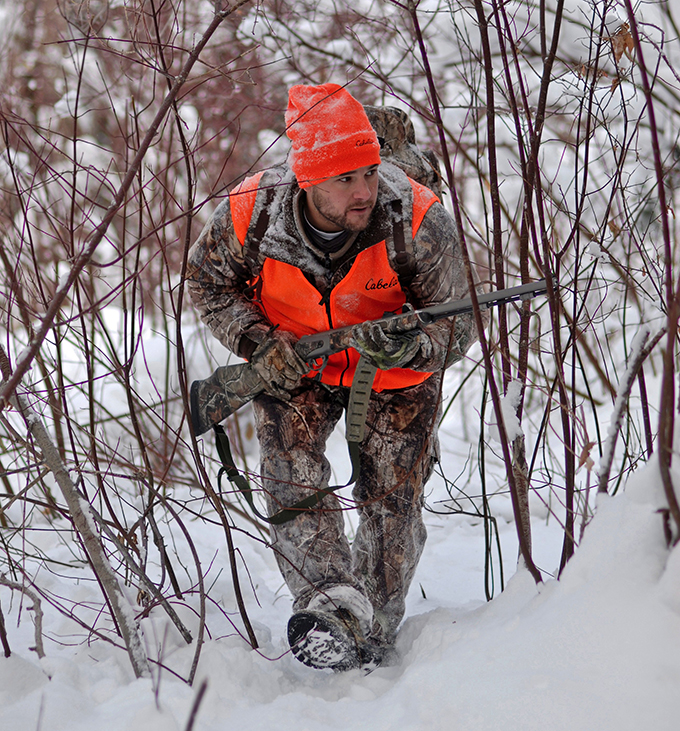We may earn revenue from the products available on this page and participate in affiliate programs. Learn More ›
Myths and misunderstandings regarding the performance and care of blackpowder rifles and propellants have cost many hunters a buck. Don’t be one of them.
If you spend any time in hunting camps, sooner or later you will hear amazing stories about the long-range performance of modern muzzleloaders.
The thing is, I have been messing with these guns for more than four decades. I have written a book and more magazine articles than I can count about them. I think I have loaded and fired more shots from muzzleloaders than the entire Continental Army did in the American Revolution, and I have yet to see the sort of performance I hear of around the campfire.
Hunting stories are wonderful things; facts are pesky little critters that suck the fun out of them. Let’s take a look at a few, shall we? (Facts, that is.)
Accuracy
I picked at random 30 three-shot 100-yard groups from several modern in-line muzzleloader rifles I have tested. The average group size is 2.24 inches.
Sure, some guns shoot better than that, but some guns shoot worse, too. That 100-yard average projects to exceed a deer’s 6-inch kill zone at 268 yards. That means you could miss even without all the other factors we’ve yet to cover.
Velocity
With three Pyrodex pellets, the Barnes 250-grain bullet has a muzzle velocity of 2,197 fps from a 28-inch barrel. It has 1,467 fps remaining at 200 yards. Retained velocity is 1,325 fps at 250 yards and 1,204 fps at 300 yards.
Bullet Path
With a 100-yard zero, that same bullet is 3.04 inches below the line of sight at 150 yards, 9.4 inches low at 200 yards, almost 20 inches low at 250, and nearly a yard low at 300 yards.
Gravity
The force of gravity causes the bullet to drop faster and faster as its time in flight increases. It drops more from 200 to 250 yards than it does from zero to 200 yards. Assuming a 6-inch kill zone, which is typical for deer, 3 inches in any direction can put you out of the zone—and that’s how much the bullet drops between 200 and 217 yards. By 300 yards, it only needs 9 yards of forward movement to drop 3 inches.
Energy
The muzzleloader has 2,680 ft.-lb. of energy at the muzzle and only 1,180 ft.-lb. at 200 yards. At 243 yards, the bullet falls below 1,000 ft.-lb. of energy—the widely accepted minimum needed to ethically kill whitetail deer.
Wind Drift
With even a 10 mph wind, the 250-gr. Barnes will drift 10.91 inches at 200 yards. At 250 yards it’s 17.89 inches, and 26.80 inches at 300 yards. A 15 mph wind pushes it 16.2 inches at 200 yards, 26.83 inches at 250 yards, and 40.20 inches at 300 yards.
Can you judge the wind with that kind of precision? I know I can’t. Is it 10 mph or 15 mph? Is it a perfect 90-degree angle or closer to 45 degrees? Is the wind speed and direction the same all the way to the target?
Final Word
Ballistics don’t lie. For any ethical hunter, 200 yards is about the limit of ballistic and shooter performance for a modern muzzleloader. Your best bet? Use your hunting skills to get closer. That’s what muzzleloader hunting is all about anyway.

Cold-Weather Care
Inside or out? That’s the perpetual question for the late-season muzzleloader hunter. Should you leave your rifle outside in the garage, shed, or truck? Or should you bring it inside where it’s warm and cozy at night? Experts abound in every camp, and the group is usually divided on which method is best.
Why It’s an Issue
Black powder and its substitutes are hygroscopic, which means they absorb water, which in turn will prevent them from igniting.
The theory behind leaving the gun outside or in the truck is to prevent the buildup of condensation created by bringing a cold gun into a warm room, but it ignores the fact that water exists in three states: gas, liquid, and solid. The H2O that forms condensation is already present in a gaseous state wherever there is any amount of humidity. As a gas, water has an easier time of finding your powder charge, since gases can penetrate the smallest of orifices. It will find the one spot where the bullet does not seal in the bore, or it’ll follow the threads on the nipple or the breech plug until it locates the powder charge.
You might delay this by leaving the gun outside, but under the right conditions, water vapor in the air can degrade a muzzleloader’s propellant charge. Of course, if you are in the desert where humidity is in the single digits and it hasn’t rained since the Bush administration, you have less to worry about than a guy hunting in a place where it rains or snows half the hunting season.
But is it worth the chance that your gun might not fire when the moment of truth comes crashing through the woods?
Make Sure It Fires
At the end of the hunting day, empty your muzzleloader. The easiest way to do that is to fire it, but if you can’t do that, remove the breech plug and push the charge out with a rod. Clean the gun. Now stand it, with the muzzle pointing up, close to a heat source for the night. That will warm the gun and dry out any residual moisture. In the morning, make sure the flash hole is clear and carefully reload the gun.
If the weather is questionable, seal the muzzle with electrician’s tape. Then seal the percussion cap with nail polish. Repeat the process at the end of every hunting day.
